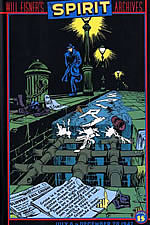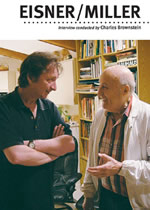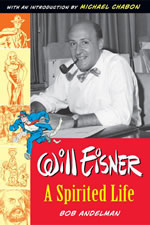Will Eisner:
Instructions From A Master

Will Eisner’s The Spirit
as adapted for film by Frank Miller
The Christmas Spirit takes on a whole new meaning this year, as many more people will be discovering Will Eisner’s discreetly masked hero The Spirit as he hits the big screen this holiday season, radically reinterpreted, or misinterpreted, by writer-director Frank Miller. Eisner was remarkably productive to the very end, from more than twelve years helming the weekly Spirit short stories, brimming with wit and invention and now compiled into hardback archives, to almost three supposedly "twilight" decades till his death spent crafting his great graphic novel library. His long career came to a close in early January 2005, not long before his 88th birthday, thus sparing him from seeing what has been wrought on the whiz-bang, big-budget screen to his low-cost, lo-fi pulp-print classic. Three years on, his last book, which he left as a first draft text and an almost ready "dummy", was given the finishing touches by Peter Poplaski and published posthumously. Expressive Anatomy for Comics and Narrative from W.W. Norton is the third and final in his planned trilogy of instructional books grouped under the subtitle, "Principles and Practices from the Legendary Cartoonist."
Like other standard references on anatomy, Eisner opens with the building blocks, the structure of the human body, the bones in Chapter 1, the muscles in Chapter 2. As he moves onto draughtsmanship in the third, he shares a charcoal study of a male figure which he drew around the age of 18 when he attended George Bridgeman’s Art Students League. Eisner still rates Bridgeman as by far the best anatomical teacher and makes no reference to the much more florid anatomy manuals by fellow comic artist Burne Hogarth, who drew the Tarzan newspaper strip. Eisner’s preoccupation is less with flayed sinews and dramatic drapery and much more with "the body grammar" of the human body. His father worked on stage sets in the theatre and Eisner repeats in his introduction his analogies likening comics to theatre, "...the artist functions like a theatrical director choreographing the action." Across the rest of the book’s seventeen chapters, he is at pains to emphasise that the study and mastery of "body grammer" is vital in crafting comics: "The expression of human emotion is displayed by behavior articulated by meaningful postures. Often, to achieve a particular expression the gestures may require distortion or exaggeration."
For examples to demonstrate this point, through the rest of the book he has selected complete tales - two Spirit classics, a Vietnam war tale Hard Duty - and extracts from his graphic novels and shorter stories, on occasion in both pencilled and finished form. Two American greats are also spotlighted by him - a chapter on Charles Dana Gibson’s genius at gesture and posture, and an action sequence from a 1965 Captain America Marvel comic by Jack Kirby, whose "accuracy of the underlying structure enabled him to employ the simplification and exaggeration that is needed to portray power and brute force." One wonders how many superhero artists today truly know the fundamentals of anatomy and how many start only from the foreshortened, pumped-up distortions common to comic books of the genre. Eisner also offers plenty of previously unpublished character studies, for example showing various emotions, most of these inked from his pencils by Poplaski, who also drops in helpful captions, derived from hours of Eisner’s interviews and lectures, to accompany most of the strip examples. On facial types and expression, on physiognomy and caricature, Eisner goes right back to William Hogarth and Rodolphe Töpffer, before presenting some of his own fine initial character sketches of members of his graphic novels’ casts. Proof that he practised what he preached, and proof that these lessons always need to be learnt.

To coincide with this all-new title, W.W. Norton have also brought Eisner’s two foundational instruction books back into print, which benefit from much improved layouts and typography. Based on his course at New York’s School of Visual Arts, Comics & Sequential Art first appeared in 1985 and was self-published by Poorhouse Press, Florida, operated by Eisner and his brother Pete and revised in 1991 with the seventh printing. The reproduction in this new Norton edition is far superior, notably on the Hamlet on a Rooftop where subtle pencil shadings shine through, all but lost in the original version’s coarse halftone screening. Other images, such as some of the roughs, are much clearer, and more covers and interiors of Eisner’s educational and informational comics are shown here. The other "new and updated material" consists of four spreads showing related examples from Jason, Alison Bechdel, Robert Crumb and Jason Lutes with Nick Bertozzi, courtesy of James Sturm from the Center for Cartoon Studies.

Hamlet On A Rooftop
by Will Eisner
On occasion though, this latest edition is not as good as the original, in particular the photos on the storyboard example, which appear far too dark. The most significant new text and graphics is in the last chapter, not surprisingly. In the earlier version, Eisner concluded: "Regardless of the wider latitudes for rendering which more sophisticated reproduction technology offers, this medium remains a line-art form. Line rendering has a crispness of statement that is very useful in the employment of imagery as a language. The artist should continue to think in line for the foreseeable future." This rather cautious prediction has been dropped in place of an explanation of Digital Art and The PC and The Process, covering current computerised production, while a further section looks at webcomics and digital delivery, these updates benefitting from input by Gary Chaloner. The book now concludes that what really still counts, the affirmation that beyond the "simple manipulation of a machine" will be the ability to "generate images that are singular,stylistic and idiosyncratic, reflecting the artists’ distinctive personality. All the evidence at hand indicates that personality or individuality in the practice of sequential art will continue to come from its combination with the generation of ideas and mastery of narrative style."
Graphic Storytelling & Visual Narrative, his second guide, has also been spruced up for this fresh edition. I’ll admit I am chuffed that Eisner’s quotation from my 1990 Daily Telegraph article has survived uncut. Again some of the original reproductions, such as the detailed engraved animals on page 14 and the flat grey behind the symbols on page 15, for instance, have printed a bit murkier than the earlier printing. New additions here are spreads with a lesson from the Center for Cartoon Studies on "Making A Comic Book" by Kevin Huizenga.

How To Draw Comics
by Kevin Huizenga
Other interludes are by Gabrielle Bell, R. Sikoryak and Bryan Lee O’Malley. Most intriguing, a totally different rough, pencilled version of the 7-page tale The Last Vote is presented here. Some very odd half-tone effects on the opening three pages of The Long Hit are thankfully absent from this crisper, clearer version. A whole chapter is dropped, Chapter 11 on Electronic Delivery, in which Eisner envisioned the future for comics as they convert from print to video, via video or CD Roms - a path and a medium that did not take off as he’d anticipated. There follows his graphic introduction to Moby Dick, "The White Whale", 52 same-size panels which formed the basis for his later Moby Dick adaptation from NBM. Again Chaloner helps to bring this book into the 21st century by examining comics on the internet. And still there are Eisner’s thought-provoking questions on technology’s continuing impact on the creation of comics.
Expressive Anatomy For Comics & Narrative completes his trilogy of practical manuals which will go on to instruct and inspire generations of graphic storytellers, and it completes Eisner’s lifetime dedicated to the comics medium.
Posted: December 28, 2008


















